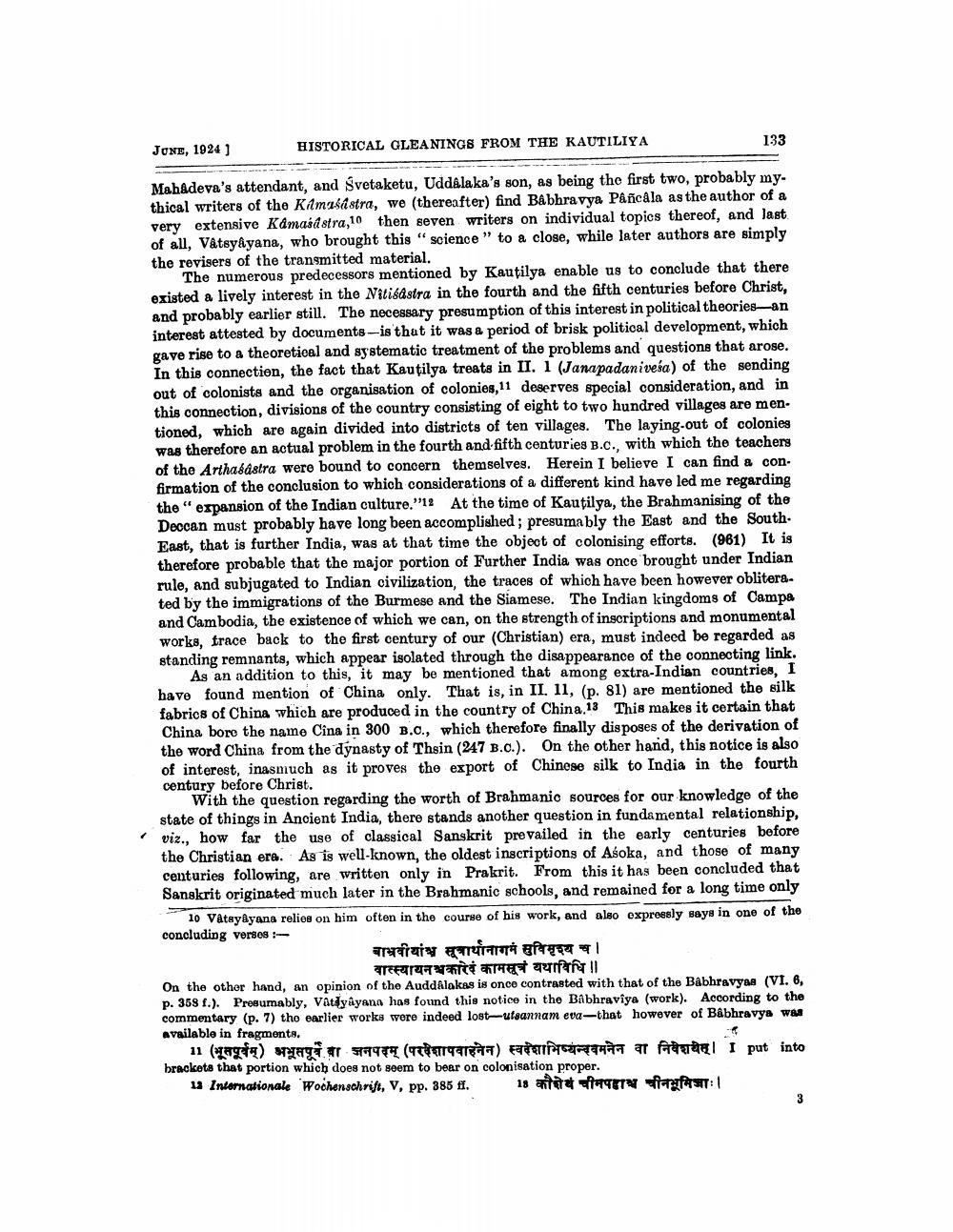________________
JONE, 1924)
HISTORICAL GLEANINGS FROM THE KAUTILIYA
133
Mahadeva's attendant, and Svetaketu, Uddalaka's son, as being the first two, probably mythical writers of the Kamasastra, we (thereafter) find Babhravya Pancala as the author of a very extensive Kamasdetra,10 then seven writers on individual topics thereof, and last of all, VatsyAyana, who brought this "science" to a close, while later authors are simply the revisers of the transmitted material.
The numerous predecessors mentioned by Kautilya enable us to conclude that there existed a lively interest in the Nilibastra in the fourth and the fifth centuries before Christ, and probably earlier still. The necessary presumption of this interest in political theories—an interest attested by documents-is that it was a period of brisk political development, which gave rise to a theoretical and systematic treatment of the problems and questions that arose. In this connection, the fact that Kautilya treats in II. 1 (Janapadaniveía) of the sending out of colonists and the organisation of colonies, 11 deserves special consideration, and in this connection, divisions of the country consisting of eight to two hundred villages are men. tioned, which are again divided into districts of ten villages. The laying out of colonies was therefore an actual problem in the fourth and fifth centuries B.C., with which the teachers of the Arthasastra were bound to concern themselves. Herein I believe I can find & con. firmation of the conclusion to which considerations of a different kind have led me regarding the "expansion of the Indian culture.”'12 At the time of Kautilya, the Brahmanising of the Deocan must probably have long been accomplished; presumably the East and the South East, that is further India, was at that time the object of colonising efforts. (961) It is therefore probable that the major portion of Further India was once brought under Indian rule, and subjugated to Indian civilization, the traces of which have been however obliterated by the immigrations of the Burmese and the Siamese. The Indian kingdoms of Campa and Cambodia, the existence of which we can, on the strength of inscriptions and monumental works, trace back to the first century of our (Christian) era, must indeed be regarded as standing remnants, which appear isolated through the disappearance of the connecting link.
As an addition to this, it may be mentioned that among extra-Indian countries, I have found mention of China only. That is, in II. 11, (p. 81) are mentioned the silk fabrics of China which are produced in the country of China.13 This makes it certain that China bore the name Cina in 300 B.O., which therefore finally disposes of the derivation of the word China from the dynasty of Thsin (247 B.C.). On the other hand, this notice is also of interest, inasmuch as it proves the export of Chinese silk to India in the fourth century before Christ.
With the question regarding the worth of Brahmanio sources for our knowledge of the state of things in Ancient India, there stands another question in fundamental relationship, viz., how far the use of classical Sanskrit prevailed in the early centuries before the Christian era. As is well-known, the oldest inscriptions of Asoka, and those of many centuries following, are written only in Prakrit. From this it has been concluded that Sanskrit originated much later in the Brahmanic schools, and remained for a long time only
10 Vâtsy@yana relies on him often in the course of his work, and also expressly says in one of the concluding verses
बाभ्रवीयांश सूत्रार्थानागमं सुविमृश्य च ।
वात्स्यायनश्चकारे कामसूत्रं यथाविधि ॥ On the othor hand, an opinion of the AuddAlakas is once contrasted with that of the Babhravyaa (VI. 6, p. 358 f.). Presumably, Vaudyâyana has found this notice in the BAbhraviya (work). According to the commentary (p. 7) the earlier works were indeed lost-utsannam eva--that however of Babhravya wat Available in fragments. 11 (sag) agar 47977 (Terra) Fate
at f ar I put into brackets that portion which does not seem to bear on colonisation proper. 12 Internationale 'Wochenschrin, V, pp. 385 tl. 18 aitare
AST:
-




